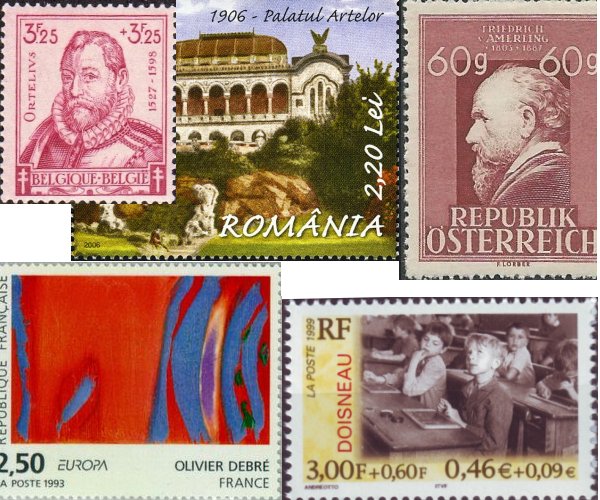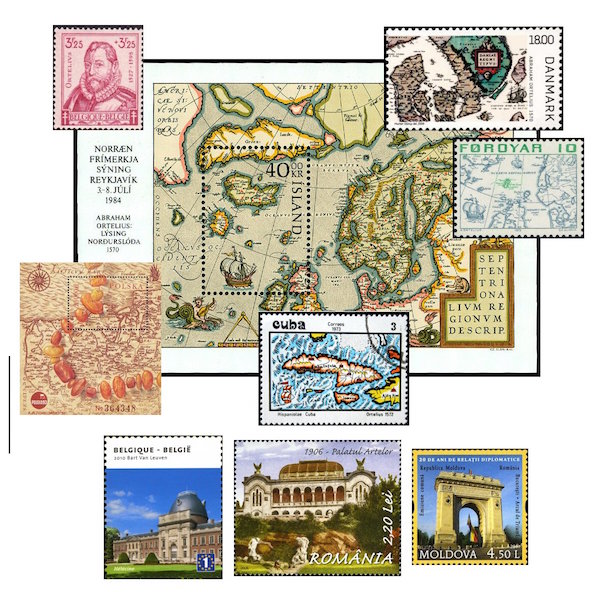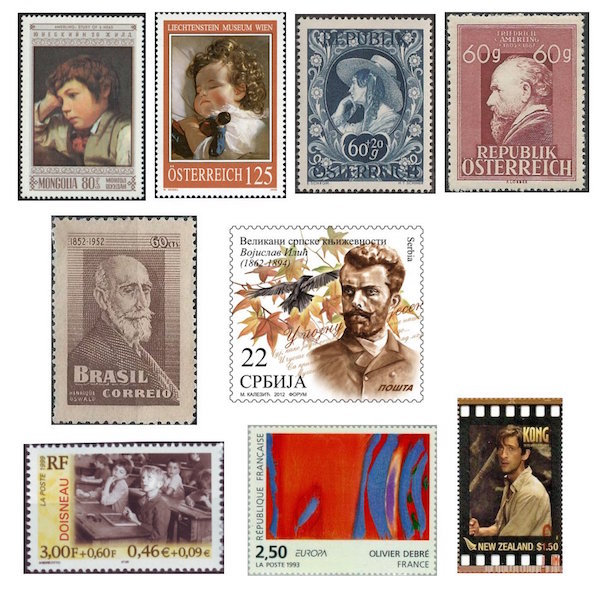The Arts on the Stamps of the World — April 14
An Arts Fuse regular feature: the arts on stamps of the world.

By Doug Briscoe
Brownie points if you’ve heard of more than two of today’s birthday honorees. Ready? Abraham Ortelius, Laurent-Benoît Dewez, Victor Ştefănescu, Friedrich von Amerling, Henrique Oswald, Vojislav Ilić, Robert Doisneau, Olivier Debré, and Adrien Brody. Well, not including Adrien Brody; too easy.
To my surprise, finding stamps for cartographer Abraham Ortelius (aka Ortels, Wortels; 14 April 1527 – 28 June 1598) was easier than finding them for Mercator. Ortelius created what is believed to be the first modern atlas of the world, the Theatrum Orbis Terrarum, in 1570. Moreover, he seems to have been the first person to have proposed the theory of continental drift. Born in Antwerp, Ortelius began his career as a map engraver and illuminator. He traveled widely, meeting Mercator in 1554 at the Frankfurt book and print fair, and was made geographer to King Philip II of Spain in 1575. He had already made maps of Egypt, Asia, and Spain besides his world map. As stated above, he was the first known person to discern the conformity of shape of the land masses on either side of the Atlantic and was cited by Alfred Wegener in his historic 1912 paper on the subject, which eventually led to our understanding of plate tectonics. Ortelius was painted by Rubens and has been acknowledged on stamps of Belgium, Denmark, the Faroe Islands, and Cuba and minisheets from Iceland and Poland.
I want to deal with our two birthday architects side-by-side even though they are separated in time by more than a century and worked at opposite ends of Europe. Laurent-Benoît Dewez (14 April 1731 – 1 November 1812) was born near Verviers, met Robert Adam in Italy and worked with him in London in 1758. The next year he returned to what was then the Austrian Netherlands and started work on refurbishing the abbey of Orval. He went on to produce abbeys, churches, and chateaux. The Belgian stamp shows his Opheylissem Castle, formerly an abbey, in Hélécine.
Victor Ştefănescu (or Stephănescu, 1877–1950) worked exclusively in Romania following his studies in Paris. Two of his creations for Bucharest can be seen on stamps of Romania and Moldova: the Palace of Arts (1905) and the Triumphal Arch (1935). Ştefănescu’s father, by the way, was the composer George Stephănescu (he has a stamp, too, but we won’t see it until his birthday in December.)

Now we turn back to the 19th century for the Austro-Hungarian portrait painter Friedrich von Amerling (14 April 1803 – 14 January 1887). He was court painter for the Emperor Franz Josef for 45 years (1835-80). What we see on the stamp from Mongolia, however, is a more domestic subject, a Portrait of [his son] Andreas Amerling (1829). Combining officialdom with domesticity is his Portrait of Princess Marie Franziska von Liechtenstein Aged Two (1836). Maiden With a Straw Hat (c1835) shows up on an Austrian stamp of 1947, and Amerling himself was honored the next year. Another of his many portraits was of Franz Liszt.
On this date in 1852, Brazilian composer and pianist Henrique Oswald was born in Rio de Janeiro to a Swiss-German father (named “Oschwald”), who sold pianos, and an Italian mother, who was a music teacher. He gave his first recital at twelve and studied in Florence from the age of 16. Apparently he did not return from Europe until the twentieth century, when he became director of the Instituto Nacional de Música in Rio (1903-06). His numerous compositions include many works for the piano, three operas, a symphony (1910), a piano concerto and one for violin, a mass, a requiem, and chamber music. Henrique Oswald died on June 9, 1931. Brazil issued a stamp for his centenary in 1952.
The father of Serbian poet Vojislav Ilić (14 April 1860 – 21 January 1894), Jovan Ilić, was also a poet and playwright. Vojislav’s first poetry volume appeared in 1887, and he was soon much celebrated, some critics even labeling him “the greatest Serbian poet”. He died of tuberculosis before his 34th birthday.

Two French artists, a photographer and a painter, are up next. Robert Doisneau (14 April 1912 – 1 April 1994) is known for his street photography, his gentle humor, and his status as one of the first photojournalists. Probably his most famous photos are Le baiser de l’hôtel de ville (Kiss by the Town Hall, 1950) and Picasso and the Loaves (1952), but he left many delightful pictures of children, and one of them, a struggling young mathematician, was chosen for Doineau’s entry in a 1999 set of stamps honoring French photographers. There’s a good article with many examples of his work here.
Speaking of Picasso, Olivier Debré (14 April 1920 – 1 June 1999) met him in 1941 and turned away from representational work to the abstract, specifically to what he called “fervent abstraction”, designed to arouse an emotional response (presumably a positive one; negative wouldn’t be very challenging). Debré often worked on a large scale for the stage, with curtains for the Comédie Française, the Hong Kong Opera, and for the new Shanghai Opera House. In another case of the cross-fertilization of the arts, choreographer Carolyn Carlson in 1997 created a ballet, Signes, inspired by Debré’s Signes-figures of the 1950s and Signes-paysages from the 1960s. The 1993 stamp reproduces his Rouge rhythme bleu.
One may find it a touch ironic—or a sign of the times—that there is no stamp for the great John Gielgud (1904 – 21 May 2000), but that one can be found for Adrien Brody (born 1973; no offense intended to Mr. Brody): it’s from a New Zealand set promoting Peter Jackson’s (very good) 2005 remake of King Kong. Given that we just yesterday wished a happy birthday to Doctor Who No. 5, Peter Davison, it would be churlish of me not to send felicitations to Doctor No. 12, Peter Capaldi (born 14 April 1958), even though he is absent from the British Doctor Who sheet of 2013.
A graduate of the University of Massachusetts with a B.A. in English, Doug Briscoe worked in Boston classical music radio, at WCRB, WGBH, and WBUR, for about 25 years, beginning in 1977. He has the curious distinction of having succeeded Robert J. Lurtsema twice, first as host of WGBH’s weekday morning classical music program in 1993, then as host of the weekend program when Robert J.’s health failed in 2000. Doug also wrote liner notes for several of the late Gunther Schuller’s GM Recordings releases as well as program notes for the Boston Classical Orchestra. For the past few years he’s been posting a Facebook “blog” of classical music on stamps of the world, which has now been expanded to encompass all the arts for The Arts Fuse.
